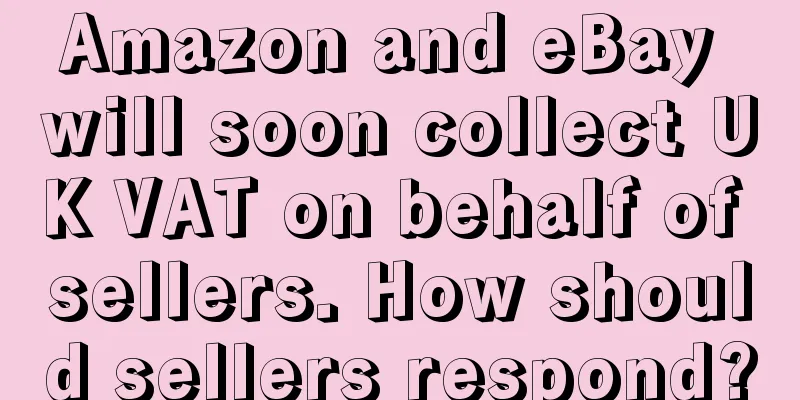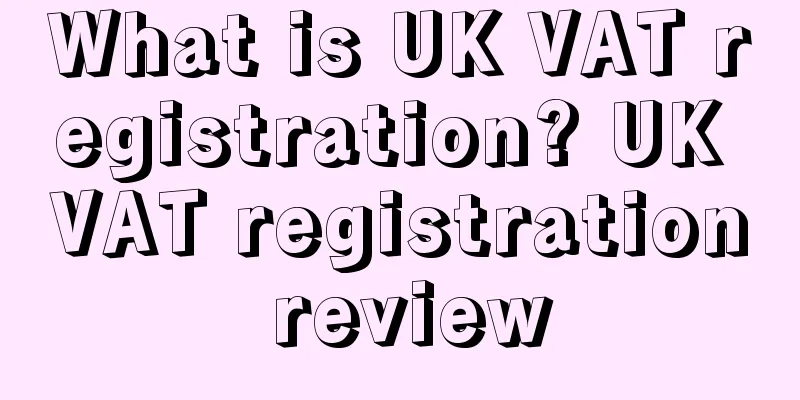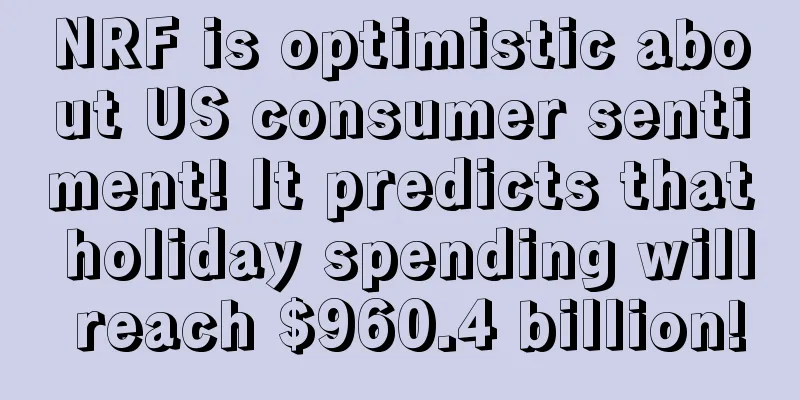Amazon and eBay will soon collect UK VAT on behalf of sellers. How should sellers respond?

|
As early as mid-to-late October, Amazon issued a new notice to sellers on the "UK e-commerce VAT regulations" , indicating that the UK will officially withdraw from the EU single market and customs union on January 1, 2021. From this date, the UK will introduce a new set of VAT rules. Among them, the biggest change is that the VAT on the UK site will be collected by Amazon from next year.
Although Amazon has already sent emails to inform sellers that the UK will implement new VAT collection rules, today Amazon again notified sellers in the form of background news that the change in VAT regulations will take effect on January 1, 2021, which shows the importance of this change.
Although there has been a detailed explanation of the changes in VAT regulations in the email, many sellers still expressed confusion about this policy. Today, the editor will provide you with an introduction to the changes in VAT regulations on various platforms after Brexit and how to deal with them.
According to Amazon Backstage News, Amazon will be responsible for collecting UK VAT on sales of the following items delivered to UK customers through any Amazon storefront: 1. Goods delivered from stock stored outside the UK, with a maximum parcel value of £135; 2. Goods delivered from stock held within the UK, regardless of value, wherever you are located. Regardless of which supply method you use, Amazon will calculate and collect UK VAT from customers at checkout and remit it directly to the UK tax authorities. You will not receive UK VAT amounts in your payments and you will not be required to remit these amounts to the UK tax authorities. In the previous email, Amazon also clearly stated the two situations in which Amazon collects or does not collect VAT on behalf of customers:
Situations where Amazon collects and remits applicable VAT: If you ship products from UK inventory to UK customers and your business is established outside the UK, Amazon must collect and remit applicable VAT. This applies to both sellers in the UK using Fulfillment by Amazon and sellers using third-party fulfillment methods. Amazon does not collect and pay VAT on behalf of customers: If you ship products from outside the UK to a UK customer and that customer is VAT registered in the UK (business and institutional customers), Amazon does not need to collect and remit VAT on your behalf. VAT registered customers can self-declare the UK through their VAT return. In addition, there are several changes in the new VAT regulations that sellers should pay attention to:
That is, from January 1, 2021, goods delivered to UK customers from warehouses in or outside the UK will no longer be tax-free. At that time, Amazon will calculate UK VAT and charge fees on these sales, regardless of their value. Many sellers on the UK site said after seeing the above news: This is simply the end of small and light items, and it is becoming increasingly difficult to do business on the European site. However, with Brexit, not only Amazon but other e-commerce platforms will also be subject to the new UK VAT regulations.
Recently, eBay announced that it will collect and pay UK value-added tax on behalf of merchants starting from January 1, 2021.
It is learned that eBay's rules for collecting and paying UK VAT apply to the following situations:
● For goods imported into the UK and sold to consumers in the UK with a value of no more than £135.
● For non-UK business sellers, goods pre-warehoused in the UK and sold to UK consumers. The UK will cancel the current VAT exemption for low-value goods imported into the UK with a value of no more than £15.
At the same time, from March 1, 2021, eBay will require all listings on eBay UK and eBay EU sites to provide VAT rates.
In this regard, sellers are advised to immediately check and amend their listings on eBay UK or any eBay EU site to provide the applicable VAT rate. If the seller does not have any EU or UK VAT number (VAT ID), when modifying existing listings or creating new listings, the seller can fill in 0% in the VAT rate column.
In fact, as early as October, when Amazon released a notice about the change in UK VAT, it reminded sellers to pay attention to this change. As soon as the news came out, many sellers on the European site were not calm, and various opinions emerged.
Some sellers support this view and believe that it is a good thing for Amazon to pay taxes on behalf of others, so that everyone can pay taxes in a formal manner. ▲ The picture comes from Zhiwubuyan But some sellers disagree: Amazon is only paying on behalf of the seller, and the service provider still needs to declare the tax. In this way, the seller not only has to pay the actual tax, but also the agency fee.
Some sellers also mentioned the issue of the future selling price of the product: If tax evasion cannot be achieved, the price must be increased, and my selling price will not seem so expensive~ ▲ The picture comes from Zhiwubuyan But more sellers have a negative attitude towards this change and are also worried about the future survival of the European and British sites.
"Such a high VAT? Too harsh. My capital is at risk..." "This will fatten Amazon's pockets, and sellers will suffer huge losses." "The UK cannot report a lower amount, or it will be in trouble." "If we keep doing this, everything will be in tatters."
In fact, the biggest impact of the platform's collection and payment of value-added tax on sellers is increased costs and reduced profits. As a result, it is inevitable to increase product prices, but consumers may not be willing to pay for them. In the end, it is difficult to predict whether the sales volume of the UK site will be considerable, and the probability of subsequent customer refunds will also increase.
For sellers who ship their own goods in the UK, most of their products are small items. In addition, the cancellation of the £15 VAT exemption policy will reduce their price advantage, making many sellers who ship their own goods feel the pressure doubled.
As the day for the implementation of this regulation is getting closer, sellers must pay attention to it, familiarize themselves with the specific changes in the rules, and make preparations early. In response to the changes in Amazon UK VAT regulations, sellers need to confirm and implement the following two points in a timely manner: ▼Please ensure that the details of your Seller Central account are up to date - you will need to review and update your company registration address, as well as the actual "shipping address" information. ▼The market price published on Amazon always includes VAT.
1. Ensure that there is inventory in the UK and the EU Sellers can split their inventory and send it to the UK and EU respectively, thereby safeguarding sales in both the UK and EU and ensuring there is sufficient stock on both sides of the new border that comes into effect on January 1, 2021. 2. Prepare VAT number If goods are shipped across borders and stored locally, the seller needs to provide the VAT number of the country or region where these goods are stored. 3. Obtain an EORI number EORI refers to a registration number required for any business that has economic activities in a European country, especially import and export business. From January 1, 2021, an EORI will be required for the UK and any other EU country or region where the seller intends to transport goods. In addition, sellers must adjust their products according to local government requirements and platform rules. At this time, they can consider abandoning some products in the red ocean with low profits. In addition, they should try to enhance the advantages of supply chain and logistics , while doing a good job in product branding, using FBA more often, and doing a good job in VAT declaration.
The above is a detailed explanation and response method for the changes in the UK VAT regulations. I hope that sellers can put it into practice, pay attention to this change, and prepare for Brexit as early as possible.
I wonder what sellers think about Brexit and the platform's collection and payment of VAT. Welcome to leave a message in the comment area~ Statement: When reprinting this article, the title and original text must not be modified, and the source and original link must be retained. |
<<: Revealed: What is the black technology that can delete comments and restore links?
>>: Nothing else, this Double 12, N kinds of discounts, 1 to support you - EU Cross-border Circle
Recommend
In the post-epidemic era, Americans are buying bigger and bigger TV screens! High-end models hit a 5-year high
According to the latest data from NPD Group, over ...
Practical operation: Don’t look for a service provider, the latest 2023 brand registration and cancellation process
1. Influencer video: 300, including shooting and u...
What is China Enterprise Dynamics? China Enterprise Dynamics Review
China Enterprise Dynamics Technology Co., Ltd. was...
Amazon's category purge! Exchange rate plummets, strikes surge, Prime Day becomes a "shopping robbery"?
▶ Video account attention cross-border navigation ...
What is the online literature navigator? Online literature navigator review
Online Literature Navigator is the first one -stop...
What is Cross-border Tongbao? Cross-border Tongbao Review
Cross-border Tongbao E-commerce Co., Ltd. (referre...
U.S. online grocery sales reached $9.9 billion in August, with delivery leading the growth
It is learned that on September 17, according to f...
What is Shopzilla? Shopzilla Review
Shopzilla is a well-known American comparison shop...
Six tips to help you create beautiful Amazon product videos!
Product videos are a key part of e-commerce sales...
Big news! Amazon is reducing the burden on sellers and officially canceling a fee!
Normal, once there is data abnormality, such as s...
Amazon cracks down on fake reviews again, and a large number of seller accounts have been blocked!
The wind is whistling and the Yishui River is cold...
American consumers prefer "buy online, pick up offline"! They are enthusiastic about same-day delivery services!
<span data-docs-delta="[[20,"获悉,根据PYMNTS的“...
Are you being followed by others? Here are 10 tips to help you fight back
I believe that many sellers have encountered such ...
What is Repricelt? Repricelt Review
Repricelt is a tool that reprices prices based on ...
What is TouchSite? TouchSite Review
TouchSite is a good helper for independent website...









